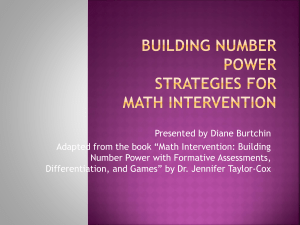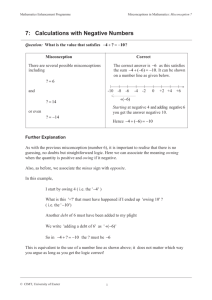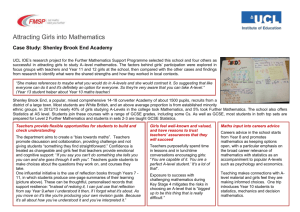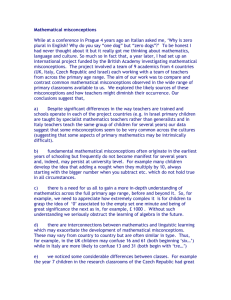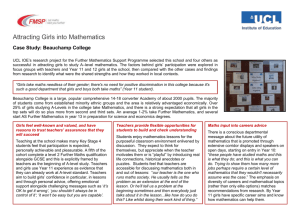Click here for presentation materials
advertisement
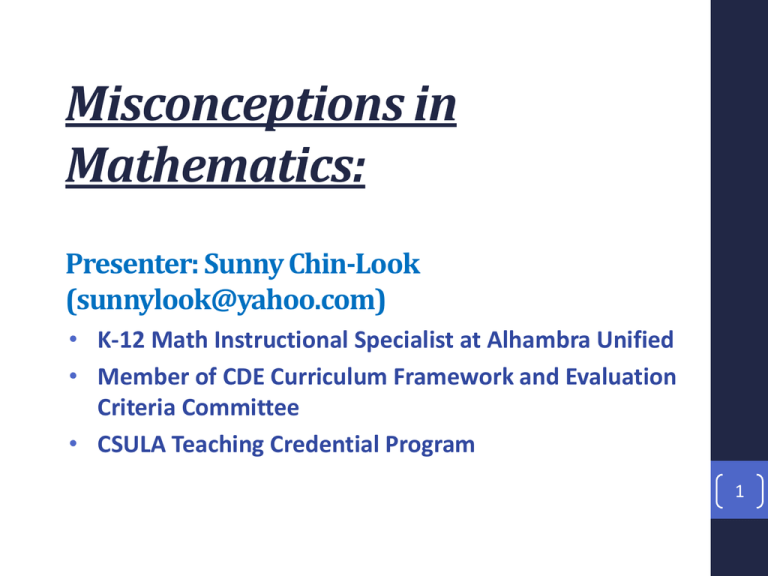
Misconceptions in Mathematics: Presenter: Sunny Chin-Look (sunnylook@yahoo.com) • K-12 Math Instructional Specialist at Alhambra Unified • Member of CDE Curriculum Framework and Evaluation Criteria Committee • CSULA Teaching Credential Program 1 Misconceptions alternative conceptions or intuitive theories Students’ erroneous, illogical or misinformed math understandings. 2 Misconceptions Impede Learning The Origins of Misconceptions 3 What does learning look like under CCSSM? 1. Make sense of problems and persevere in solving them 2. Reason abstractly and quantitatively 3. Construct viable arguments and critique the reasoning of others 4. Model with mathematics 5. Use appropriate tools strategically 6. Attend to precision 7. Look for and make use of structure 8. Look for and express regularity in repeated reasoning 4 Won’t Work 5 Hard Nuts to Crack 610 is not closer to 500 than 400. 6 4+5=7 “The problem I want to solve is 4 + 5, but I did 4 + 4, and then since 4 + 5 is one away from 4 + 4, I had to take one away” Vol. 20, No. 5 | teaching children mathematics • December 2013/January 2014 7 possible origin? Double Plus or Double Minus 8 48 – 19 = 27 “ I added 1 to 19 so I have to take away 1 from 48. 47 – 20 = 27” 9 possible origin? 28 + 15 “ Since I added 2 to 28, I need to minus 2 from 15. 30 + 13 = 43” 10 965 ÷ 16 Vol. 17, No. 7, March 2012 MATHEMATICS TEACHING IN THE MIDDLE SCHOOL 11 possible origin? 10 50 2 7 500 350 100 14 17 × 52 = (10 × 50) + (10 × 2) + (7 × 50) + (7 × 2) = 500 + 100 + 350 + 14 = 964 Array Model for Multiplication 12 Raccoon Eyes 13 Error Location and Counterexample • determine conceptual reasoning. • Confront student with counterexamples to their misconception. 14 Seating Chart This is the seating chart for Mrs. Blake’s class. One student sits at each desk. = one desk At the beginning of the year, 5/8 of the students were girls. A new student was added to Mrs. Blake’s class, and now 3/5 of the students are girls. Is the new student a boy or girl? 15 Student #1 The fraction of the class for girls increased so the new student is a girl. 16 Student #2 The new student was a girl. I got 5/8 from the girls and then I found a common denominator. The 2 numbers from the girls was 26/40 (after) and 25/40 (previously). This means they got a new student because if you – (minus sign) 26/40 – 25/40 = 1/40 which = a new student. The boy technically lost a student because they didn’t get a new student. 17 Student #3 1. First, I changed both the fractions to the same denominator. I did this so that I could compare to see if the total had 1 more student or 1 less. 2. After , I compared it and found out that there was one less girl. So, I thought that the new student was a boy. 18 Student #4 1 1/24 of the new boy 19 Free Online Resources How Do I Get My Students Over Their Alternative Conceptions for Learning? http://apa.org/education/k12 Student Thinking: Misconceptions in Mathematics www.math.tamu.edu/~snite/MisMath.pdf Nix the Tricks (eBook free download) nixthetricks.com/ Error Patterns in Computation (Sample Chapters) http://www.pearsonhighered.com/assets/hip/us/hip_ us_pearsonhighered/samplechapter/0135009103.pdf 20


